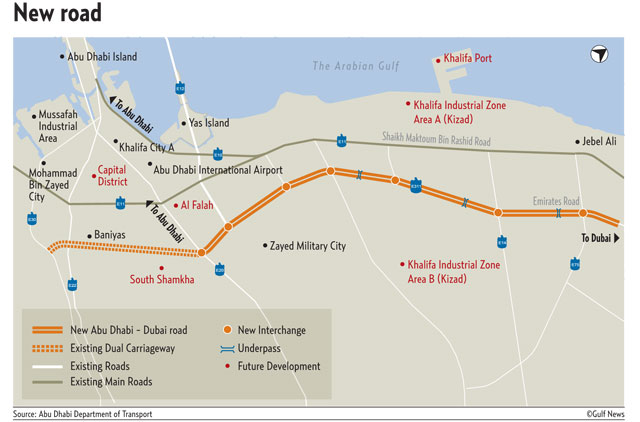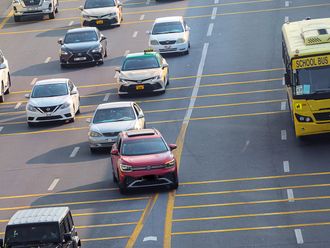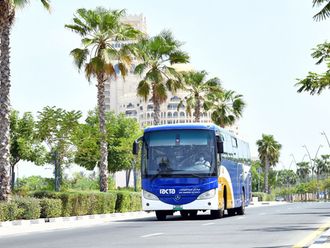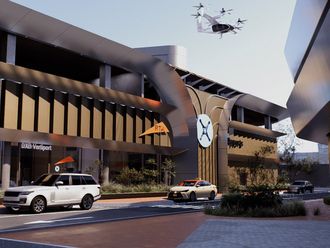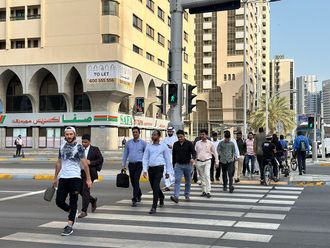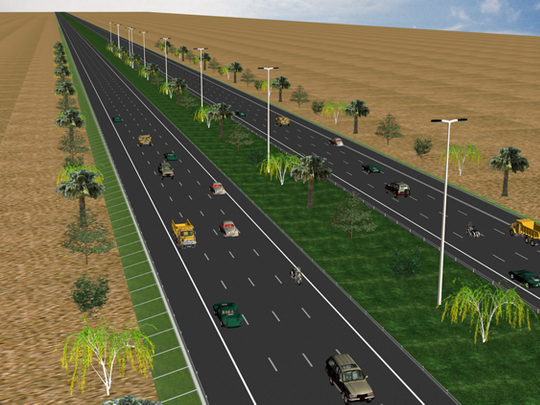
Abu Dhabi: The Department of Transport (DoT) in Abu Dhabi on Monday invited local and international bids for a new Abu Dhabi-Dubai motorway (E311), expected to be completed by the end of 2014.
The Dh2-billion project aims at reducing traffic congestion on the current main road connecting Abu Dhabi to Dubai (E11), and providing a new strategic link between the country's two most populous emirates, as well as creating new points of entry to the city of Abu Dhabi, Abu Dhabi International Airport, and Yas and Saadiyat Islands.
The motorway is one of the biggest infrastructure projects the DoT is working on as part of its Surface Transport Master Plan (STMP).
Protective structures
It will serve the Khalifa Port Area and the South Shamkha, Wathba and Baniyas residential areas and labour camps, and will accommodate light vehicles as well as trucks.
The road will also cater to the new Khalifa Industrial Zone (Kizad A and B) at Taweelah as the road is being designed to accommodate up to 7,000 vehicles per hour. The new main road will also facilitate connectivity to Al Ain as it links up with E22 (Abu Dhabi-Al Ain main road) and the rest of the road network in the Emirate of Abu Dhabi.
The motorway will be 62km of dual carriageway starting at the end of Emirates Road in Seih Shuoaib through Al Maha forest and Khalifa Port Industrial Zone (B) and will join up at the Sweihan Road (E20) interchange.
The construction will be executed through two tenders. The first tender is to construct 34km with three interchanges; the second will be to lay 28km and will also include three new interchanges and modification of an existing one.
The main road will also have a number of protective structures for service lines, especially for gas pipelines on the route.
It is expected that the work will be completed in 30 months.
Executing the project through two separate contracts will ensure competitive pricing, reduce project risks and will expedite the completion and delivery.
The road project is the result of detailed surveys on traffic volume between Abu Dhabi and Dubai. It will serve numerous local commuters along the way and provide an alternative road to the current Abu Dhabi-Dubai main road (E11).
Sustainable standards
Some 800 light columns standing 30-metres tall at 300-metre intervals will light up the new main road.
It will follow best sustainable standards aimed at reducing energy consumption to be environmentally friendly and reducing operational costs. Sustainability will be achieved by reducing power demand in the off-peak periods.
For optimal road safety, the new road will feature six lay-bys, three in each direction of the main road at 20km intervals. The road shoulders will be three metres wide.
The 20-metre-wide median is designed for a staged upgrade and future expansion through the addition of two lanes in each direction, if needed.
The lay-bys are designed for emergency use by light vehicles and heavy trucks and they will also serve as patrol point for police, ambulance, and emergency vehicles.
U-turns
In addition, the road will have five points allowing for U-turns for emergency by official vehicles.
Adding to road safety will be a rainwater drainage system. It will be fenced up on either side to prevent crossing by camels.
Guard rails in each direction along the median will prevent median crossings and contain vehicles to the carriageways.


